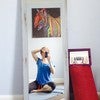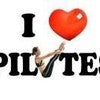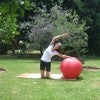Description
About This Video
Transcript
Read Full Transcript
Hi, I'm Ruth Alpert. And today we're going to do a tutorial on the PSOAS muscle. We've done the ABS already in a previous tutorial and today we're going to go deeper into the core of the body, deeper to the spine, into the center of the body, and talk about the soul as it's a very interesting muscle. It's um, spelled interestingly just from the get go, it's p, s o a s but the P is silent. So you say, so as there is a, so as major and as so as minor, but not everybody has a minor. And so in talking about the, so as major, even if you have a minor, they work together anyway. They don't do any, they don't do separate actions.
So we'll just talk about the, so as Major. So the first thing we should do is look at where it is because there's a lot of confusion for people. So I want to introduce my assistant Lucy. This is Lucy. She is a female pelvis. It used to be that you could only get male models, male pelvises and spines. And for many years I taught mostly women. And I was using a male model, so I named him George so that women looking at it would have one degree of separation and not identify entirely. And so, uh, just a few years ago they started making female models and you bet I grabbed one right away and I named her Lucy so that you, the women can identify and the men can have that one degree of separation.
Unfortunately, I took Lucy to Singapore where I taught just a few weeks ago and she had a spinal cord injury from being stuck in my suitcase. Very similar to how I felt when I got off the plane. Therefore, she's a little unstable. The, it was in between l four and five. So if I smoosh her down enough for spine, we'll stay put. But just in case she slips, that's not your spine. That's Lucy. So this is your femur, your thigh bone, and this is the head of the femur that creates the hip socket. This big Knob is called the greater trow cantor. And this is from the front. When we turn around, this is looking from the back.
You have a smaller knob and this is called the lesser trow canter, and it's on this knob that the PSOAS attaches. And we'll look at that in the context of the whole pelvis in just a moment. So you can find the greater trocanter on yourself pretty easily because it's more on the s towards the surface. If you sit into one hip stick hip out, there is a bone right there and you can tell your own bone because when you're on a soft tissue and jiggles, but when you're on bone, it's hard. Even if you have a lot of soft tissue on top of your bone, you'll still feel a different vibration, right?
So that's what we often talk about. Hips, I'm, I'm actually rather confused about if you notice for women, women have hips, but men don't. Men have inseams and wastes, but women have a hip measurement, but the hip socket is here. But they always say measure around the widest part of your hips. Well, very often that's for women. That's the trocanter, which is actually your leg. So what is the hip? There's a hip socket, right? There's the ball. In the socket and that's the hip socket, but generally hips could be trocanter, it could be socket, could be for some women who are more straight, it could be their pelvis so that no wonder you're confused. If you are confused, of course you're confused. Okay, so we're going to now look at the so as in a mock up of its action.
So now we have Casey who suddenly materialized because showing the, so as as a four handed job and I only have two at the moment working on growing to more arms. That would be really, can you imagine Pele's with four arms? Oh my goodness. But anyway, for now two of us will do this. The so outs attaches at the lesser crow canter and if you would just hold that there goes over the rim of the pelvis without attaching to it but does attach to the side bodies and discs of the first of all five lumbar vertebrae, one two, three, four, five. So it comes right up to here and it's rather broad. It also connects to the diaphragm, which is coming down at t 12 and anchoring down the lumbar through its tendons.
So when the soul has contracts, it's gonna move the femur.
There's more and more um, acknowledgement now that we have a gut brain, you know, so when you have a gut feeling about something that's actually a useful form of information, it's sometimes also called the enteric brain. And it's very tied in to the limbic part of your brain, the fight, flight or freeze center. So that when your nervous system senses danger of any kind, all kinds of things start shifting, one of which is your breathing changes and the, so as we'll start to contract to either bring you into playing possum, playing dead, you know, trying to curve yourself in, um, or for running away the, so ads is very involved in moving your thighs or for the crouch right before you spring to attack. And the, um, because our nervous systems are always jacked up in western 2015 life, coffee, traffic, you know, the argument with your spouse, your kids, you know, whatever. We're, our adrenals are always turned on in, in our society to some extent. And then, and so therefore the, so ads is always trying to do its biological job, which is to give us information that we're in semi danger and it'll be trying to contract. Um, and many people have very, they're so acids tend to be tight and that in turn can cause a lot of low back stories of different kinds. So it's never really a, I don't, shouldn't say never, but it's rarely a question that that's so as it's weak and needs strengthening, it's almost always the case that the SOS is exhausted and needs resting and lengthening and releasing. Um, a lot of phenomenal information about the, so as is from a woman named Liz Cook, it's Koc h but she pronounces it cook.
She has spent her entire career, um, delving into and studying the, so as muscle muscle, she teaches workshops and tele seminars and all kinds of things. She has a book called the, so as book, She just revised it. It's been out for at least 20 or more years. And I highly recommend this, uh, if you need more information about the, so as she really is an expert in it. Um, and she talks a lot about this. So as being a messenger of the nervous system that again, it's very rare that the, so as itself is injured or the problem, most of the time the, so adds goes into spasm or alerts us that there's something amiss in our core.
There's something off somewhere else and the, so as we'll be, you know, waving the red flag and going, paying attention, pay attention. Um, yeah. So as it's very interesting, it's, you know, not like a bicep. So as is very potent. And if you, uh, in terms of how big it is, it's the size of a fist filling in Yom is the, so as of the cow and one of my very early teachers that, where I learned about the, so ads first, Susan Klein had gone, was thinking about being a chiropractor. At one point she didn't follow that. But she went up to Columbia University and watched a dissection of a cadaver and she came back saying that. So as on that body was as big as a baseball bat. It's also often talked about in connection with the ILIAC. This muscle, the ILIAC, his fans out and fills the hole inside of the pelvic bones and they both connect at the lesser trow canters. So in there, in the beginning down there, they work together and it's very often called the Ileus.
So as as a complex and so very often to access your, so as it helps to feel the width of your pelvis widening. And that gives us so as more room to do its work. Um, we could, I could do entire day long workshops on the, so as, but for this tutorial we'll just leave it there. There's a lot of information from a lot of excellent teachers about the so as, and I encourage you to, um, pursue it further and learn more about it. But instead of talking more, I'm going to show with Amy some of the things you can do on your own. Here's Amy. And she's in a very ideal, typical, so as so as relaxation place with your legs up on a chair or a coffee table relative right angles.
But it doesn't have to be exact in this way because the, you've brought your Femur, your thighs up. The, so as is in a passive contraction, right? You've put slack into the PSOAS. It's not actively contracting, it's just being placed in a, in a way that it's not being stretched. And Liz Co cook suggest that you stay here for 20 minutes at least once a day to really let the SOA as completely chill out. Um, you can also do this with your feet on the floor, you know, in the hook line position. Um, you could do it with your legs on a ball as long as you're not, uh, working to keep the ball stable. But this is an excellent, uh, place to just let the Soviets relax enough. Because again, remember when a muscle, I don't know if you remember this, maybe you never knew it, but for a mat, if the muscle in isn't its complete resting state, then when it contracts, all the fibers will contract.
When it's in a 70 contracted state, you just have this much range of motion in the muscle. And that's not real strength. Real strength is all the fibers of the muscle contracting. And then you really have power out of that muscle contraction. So if you're, so as it's in a semi contracted state all the time, which most of us are, um, and when it's semi contracted, it's gonna pull your pelvis forward.
So that's a lot of the tightness in the front of the hips is the, so as shortening, the first thing you need to do is allow the so as to go back to its resting length and this position, 20 minutes, fall asleep, take a nap, don't plan your next day though. Let your mind relax as well as your so as, which is probably even harder than relaxing your as is to let your mind relax too. But it's a great thing to do before going to bed at night. You know, when you need to just chill out. Um, so that's one thing to actually engage, you know, to work the, so as in a gentle way. I'm going to have Amy slide back so she has a little more room to move. Good. It's called the [inaudible] smooch, smooch, smush yourself back. We have to come up with a name for that movement cause we all do it.
Don't you scooch, pull out. You scooch. A very simple and basic movement that you can do, keeping the, so as, as relaxed as possible. You just slide your knee and slide your foot in. Your knee will bend just to a right angle and then slide it back out again. The ideal is to keep the pelvis very, keep your pelvis very stable so that you're moving just the femur in the socket.
The PSOAS will be working gently. You don't have to micromanage the, so as it basically does its work.
So demonstrate that to bring your knee and you actually use your bones to maneuver it, right? That's not so cool. So see if it means that you don't go as far than just do one inch, but it's really better to keep the pelvis stable, but not by tramming your abs. So demonstrate that for a moment. Just yeah, and now move your leg. That's not the point. Your abs have to actually release and let go to feel the as right. You want to make as much space as you can in there.
I generally say to people, let the weight rest on your sacrum and back of your pelvis. So your lumbar spine may have a curve. May Not have a curve that depends on your structure. So don't even think about your low back. Um, you can also put your hands on your pelvic cres, uh, on the pelvis itself to monitor what you're doing. If you're doing this by yourself and just basically be as relaxed as you can.
Lengthen your neck a little more.
So when Amy pushes out the, so as is lengthening and when she comes in the, so as is passively releasing passively because the springs are doing the work right? The springs are pulling her in so she can let the femur drop down into her socket. Very often muscles will work better if you focus on bone and let the muscles do their job without micromanaging your muscles. So just in this, you want to extend the sow as and the springs and let the springs pull you in. You need just enough control so you don't come crashing in.
But hold on a second. If you resist the springs, if you use a lot of muscle energy to resist the coming in, in my point of view, it's sort of missing the point of a delicious moment of allowing the, so as again to be supple. So you want the so as to work in to lengthen and contract and lengthen and contract when as so as is tight and exhausted, it's going to stay semi contracted. And a really good way to start to get the pliability back is to let it breathe in and out. This way I didn't say what I should say very briefly as the, so as is interdigitating with the diaphragm. So when you exhale the SOA as gets pulled into length and when you inhale the so as, so there's a pump already happening in the SOA as just from your diaphragm action. So, um, demonstrate the resisting the coming in. So if you even more like, so you really don't let the carriage come in back and come in a little more like little little, but right.
You're just overworking in the SOA as is never being allowed to go into release. Right? So please don't do foot work that way. So you pull out and release in and the so as lengthens and the sow as passively contracts. Good. There's, you could do an entire reformer workout and I actually suggest Matt work, reformer, Cadillac, all of the work you could do visualizing your so az and feeling out, finding out for yourself, exploring how the, so as is involved in pretty much every PyLadies exercise, um, you know, this is a tutorial so I'm not going to take you through the whole repertoire, but go explore. It'll really make your workout more interesting. You could do exactly the same exercises I have for over 20 years, 25 years now or something.
And you just pick a different focus. So one day you focus on your hamstrings. One day you focus on your, so as one day you focus on your breath and you can give yourself an entirely new experience of the same exercises. Go play. Thank you.
Comments
Valuable gems of information, especially the understanding of origins and incertions of the psoas muscle. The functional information, of when the muscle is contracted and relaxed, will live on in my teaching fundamentals. Thank you!
You need to be a subscriber to post a comment.
Please Log In or Create an Account to start your free trial.












































